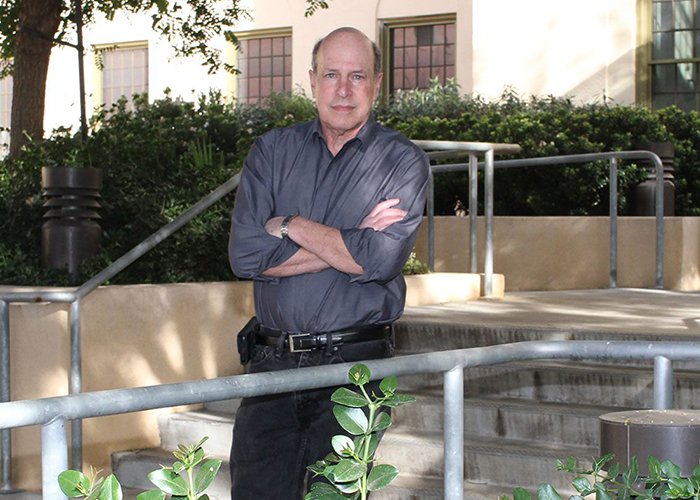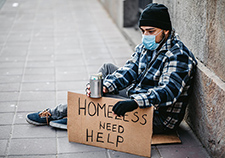Office of Research & Development |
 |


Dr. Michael F. Green directs VA’s Center on Enhancement of Community Integration for Homeless Veterans, also known as THRIVE. The program helps homeless and recently housed Veterans establish a footing in their neighborhoods. (Photo by Scott Hathaway)
February 22, 2022
By Tamar Nordenberg
For VA Research Communications
“The THRIVe Center now has the resources and expertise in place to examine—from the brain biology level to the neighborhood perspective—what’s keeping Veterans from integrating in their communities.”
VA has made real progress in reducing homelessness among Veterans in recent years. Since 2010, the number of homeless Veterans across the country has decreased by nearly 50%. VA recognizes, however, that while having a roof over one’s head is necessary, more is needed.
Enter THRIVe. That’s shorthand for a center that VA has created to help Veterans bloom within their communities—by finding work, engaging recreation, making friends, and keeping in contact with family.

Photos shed light on food insecurity in post 9/11 Veterans

Homeless Veterans largely satisfied with community health care options
The acronym is adapted from the wording of the center’s mission: “Toward Homelessness Recovery and Integration for Veterans.” The full name is the Center on Enhancement of Community Integration for Homeless Veterans. Funded in September 2020 by VA Rehabilitation Research and Development, the center aims to study and address the gap between being housed and realizing the potential to participate more fully as a member of the community, says the center’s director, Dr. Michael F. Green. Participation in employment and personal activities is crucial for both mental and physical health, Green emphasizes.
The “Housing First” model that VA follows prioritizes housing without any requirements like being sober or participating in substance abuse treatment. Once housed, Veterans continue to receive services to help them achieve their health goals, whether in mental health or other areas.
In fact, VA’s work is far from done once a Veteran has shelter, says Dr. Jack Tsai, research director for the VA National Center on Homelessness Among Veterans and professor of public health at the University of Texas School of Public Health.
“If housing is first, the question naturally becomes ‘what’s next?’” says Tsai, who collaborates frequently with Green on research into mental health and homelessness.
Tsai’s answer: Because Veterans can feel isolated in a new environment, “we must understand the factors holding them back from integrating into their communities and address these factors to help Veterans thrive in their new neighborhood.”
The old-school focus was largely limited to “There’s a roof—these individuals are safe,” says Green. An expert on neuroscience and mental illness, he has studied community integration for people with psychotic disorders. But Green points out that this perspective is dated. He says it neglects the importance of helping Veterans who were homeless, and are now housed, integrate into the community. That involves finding work, participating in interpersonal relationships and activities, and functioning independently when it comes to basic needs such as meals and transportation.
“Problems such as social isolation don’t suddenly subside because someone has shelter,” Tsai emphasizes. He says that research has documented the problem with a lack of community integration, but that much more study is needed related to supportive solutions.
Many Veterans who have experienced homelessness have job skills and backgrounds that can prove important in employment and benefit their communities. And some have become “exceptionally successful—enjoying healthy relationships, becoming productive and well-to-do in their work, and focusing on how to give back,” says Tsai. On the other end of the spectrum, some newly housed Veterans become isolated and even end up returning to homelessness.
VA created THRIVe to examine the barriers that block some from participating in work and social opportunities, and to develop ways to overcome these hurdles. Center director Green is applying findings from his research in psychosis and homelessness, which he says are “very relevant” to recently housed Veterans regardless of whether they struggle with their mental health.
Leading up to the creation of THRIVe, Green and his research team followed Veterans while they were homeless and after they received housing. They looked for predictors of community integration. In two long-term studies, Green and his team pinpointed Veterans’ motivation to engage as a primary factor. Were they willing to engage? Did they believe they would be successful in engaging with people and participating in activities? And were they looking forward to this type of community involvement? Greater motivation enhanced Veterans’ chances of successful integration—even more than their cognitive abilities, like how well they could process information.
The THRIVe researchers are carrying forward this line of study. They are looking into ways to enhance Veterans’ motivation and thereby improve their lives. For example, researchers are using a counseling method called motivational interviewing to help people find the motivation to change a behavior—in this case, to take steps toward integrating into their neighborhoods.
VA is uniquely positioned to conduct research toward improving the lives of recently housed as well as homeless Veterans, according to Tsai. He says VA is an exemplar for homeless services thanks, in part, to its large population of Veterans who have experienced homelessness and its integrated health care system, the largest in the United States. The THRIVe Center is based at VA Greater Los Angeles, which has the largest homeless program of any VA in the country and provides housing for about 9,000 formerly homeless Veterans.
Green takes pride in the diverse team of VA experts—many of whom are based in LA but whose collaborations reach across the country. The extensive range of disciplines is necessary for the center’s complex area of study, he says. Among the expert investigators, neuroscientists bring their understanding of the brain. Psychiatric rehabilitation specialists contribute their knowledge of the emotional, social, and intellectual factors in mental health. Authorities in community planning and social work focus on neighborhood factors in recovery from homelessness. And experts in clinical trial methods ensure the rigorous design and conduct of research.
While the center is relatively new, Green says he and center associate directors Drs. Robert S. Kern and Stephen R. Marder wasted no time getting studies underway and working to attract and develop clinical researchers and trainees.
“The THRIVe Center now has the resources and expertise in place to examine—from the brain biology level to the neighborhood perspective—what’s keeping Veterans from integrating in their communities,” Green states. He says the team is motivated by the awareness that, while housing represents an important step toward safety and independence, it is not the be-all and end-all for a gratifying life.
VA Research Currents archives || Sign up for VA Research updates